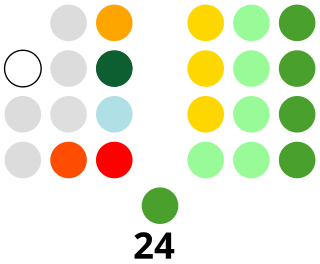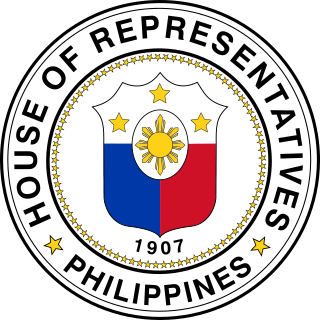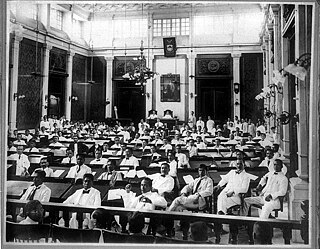
The president of the Philippines is the head of state, head of government and chief executive of the Philippines. The president leads the executive branch of the Philippine government and is the commander-in-chief of the Armed Forces of the Philippines.

The Congress of the Philippines is the legislature of the national government of the Philippines. It is bicameral, composed of an upper body, the Senate, and a lower body, the House of Representatives, although colloquially, the term "Congress" commonly refers to just the latter. The Senate meets at the GSIS Building in Pasay, while the House of Representatives meets at the Batasang Pambansa in Quezon City, which also hosts joint sessions.

The House of Representatives of the Philippines is the lower house of Congress, the bicameral legislature of the Philippines, with the Senate of the Philippines as the upper house. The lower house is commonly referred to as Congress, although the term collectively refers to both houses.

The Senate of the Philippines is the upper house of Congress, the bicameral legislature of the Philippines, with the House of Representatives as the lower house. The Senate is composed of 24 senators who are elected at-large under a plurality-at-large voting system.
Elections in the Philippines are of several types. The president, vice-president, and the senators are elected for a six-year term, while the members of the House of Representatives, governors, vice-governors, members of the Sangguniang Panlalawigan, mayors, vice-mayors, members of the Sangguniang Panlungsod/members of the Sangguniang Bayan, barangay officials, and the members of the Sangguniang Kabataan are elected to serve for a three-year term.

The government of the Philippines has three interdependent branches: the legislative, executive, and judicial branches. The Philippines is governed as a unitary state under a presidential representative and democratic constitutional republic in which the president functions as both the head of state and the head of government of the country within a pluriform multi-party system.

The Philippine Assembly was the lower house of the Philippine Legislature from 1907 to 1916, when it was renamed the House of Representatives of the Philippines. The Philippine Assembly was the first national legislative body fully chosen by elections.

Elections for the members of the Senate were held on April 23, 1946, in the Philippines.

Quintín Babila Paredes Sr., was a Filipino lawyer, politician, and statesman.
The 1st Congress of the Philippines, composed of the Philippine Senate and House of Representatives, met from May 25, 1946, until December 13, 1949, during the 22-month presidency of Manuel Roxas and the first two years of Elpidio Quirino's presidency. The body was originally convened as the 2nd Congress of the Commonwealth of the Philippines. On August 5, 1946, Republic Act No. 6 was approved, renaming the body as the 1st Congress of the Philippines.
The legislative districts of Aklan are the representations of the province of Aklan in the various national legislatures of the Philippines. The province is currently represented in the lower house of the Congress of the Philippines through its first and second congressional districts.
The legislative districts of Albay are the representations of the province of Albay in the various national legislatures of the Philippines. The province is currently represented in the lower house of the Congress of the Philippines through its first and second, and third congressional districts.

The Philippine Legislature was the legislature of the Philippines from 1907 to 1935, during the American colonial period, and predecessor of the current Congress of the Philippines. It was bicameral and the legislative branch of the Insular Government.
The 1st Congress of the Commonwealth of the Philippines, also known as the Postwar Congress, and the Liberation Congress, refers to the meeting of the bicameral legislature composed of the Senate and House of Representatives, from 1945 to 1946. The meeting only convened after the reestablishment of the Commonwealth of the Philippines in 1945 when President Sergio Osmeña called it to hold five special sessions. Osmeña had replaced Manuel L. Quezon as president after the former died in exile in the United States in 1944.

The Treaty of Manila of 1946, formally the Treaty of General Relations and Protocol, is a treaty of general relations signed on July 4, 1946, in Manila, the capital of the Philippines. It relinquished U.S. sovereignty over the Philippines and recognized the independence of the Republic of the Philippines. The treaty was signed by High Commissioner Paul V. McNutt as representative of the United States and President Manuel Roxas as representative of the Philippines.
The Constitution of the Philippines is the constitution or the supreme law of the Republic of the Philippines. Its final draft was completed by the Constitutional Commission on October 12, 1986, and ratified by a nationwide plebiscite on February 2, 1987.
Elections to the Congress of the Philippines were held on May 11, 1987. Voters elected the members of Congress in the following elections:

Jose de Jesus Roy Sr. was a Filipino lawyer, economist, and politician who served for 25 consecutive years as a congressman and senator in the Congress of the Philippines. Known as the "poor man's economist", he drafted, authored and sponsored laws to improve the lot of the peasantry. As a member of Congress, he took particular pride in the sponsorship of almost all laws on land reform. He is also considered to be the "Father of the Philippine Banking System" because of his authorship and involvement in almost all the major finance and tariff measures since the beginning of the Third Philippine Republic in 1946.










